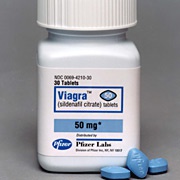Researchers may be one step closer to a Viagra for women, given the results of a British study released Tuesday.
Attempts to treat female sexual dysfunction with Pfizer's erectile dysfunction drug Viagra have for the most part failed, but a new prototype from the company offers hope for a female-specific treatment for those with female sexual arousal disorder, FSAD.
The drug, which the researchers tested on rabbits, acts by increasing blood flow specifically to the genitalia, enhancing and extending the duration of arousal.
The drug would not help all types of female sexual arousal disorder, however, as blood flow is only one of many reasons that women experience sexual dysfunction.
"This is the closest thing out there to Viagra for women," says Sheryl Kingsberg, chief of the division of behavioral medicine at University Hospitals Case Medical Center in Cleveland, "but the problem is that a Viagra-like effect will not solve the majority of sexual dysfunction cases in women.
"In contrast to men in whom erections have played a huge role in sexual health, for women arousal is not the key problem, desire is," she said.
But for the approximately 5 percent of women who have diagnosable arousal disorders related to blood flow, Kingsberg said, this treatment could be "the right option" and, fortunately, likely a safe one.
Do It Like Rabbits Researchers tested the drug by simulating arousal in female rabbits and then administering the drug to the animals. As hoped, the prototype mimicked the human body's natural processes in bolstering arousal.
By specifically blocking the enzyme in the body that checks blood flow to this region, the drug could allow for greater blood flow and greater physiological arousal, said Chris Wayman, the lead researcher on the project.
The drug would not create arousal out of nowhere, however, but would boost blood flow when accompanied by desire and sexual stimulation, Wayman said.
Why is blood flow so important?
When a woman becomes sexually aroused, emotional and physical cues in the brain tell the body to increase blood flow to the genitals; this relaxes the vagina, improves lubrication and increases sensation, Wayman said.
When there isn't enough blood flow to this area, sex can become painful and unpleasurable, and libido can drop. In other words, blood flow acts as the biological catalyst for successful sexual experiences.
But increasing blood flow throughout the body to solve the problem would be "like a shot of adrenalin" Kingsberg pointed out, so the fact that this drug is "vagina-specific" makes it more likely to be safe.
Though the prototype itself is unlikely to become a drug, Wayman said that testing the drug has helped to defog the mystery behind FSAD.
Desire vs. Arousal
But can the sexual response of a rabbit compare to the complexity of female sexual dysfunction?
According to sexual health experts, yes and no.
Rabbits have been used to study sexual health in women for decades, Kingsberg said, but their response can only compare to the physiology of sex, and then, only up to a point.
Pepper Schwartz, journalist and women's health expert, agreed
"The neuropathways [can be] similar, but it's not human and mediated by the human brain, which we know is a very complex thing. The physiological problem of blood flow is only a portion of the equation for a portion of the women with sexual dysfunction."
Also, the desire to have sex, otherwise known as libido, is not the same as the ability to become aroused, experts pointed out, and for the majority of women with sexual problems, desire is the culprit, not arousal.
While all these components are necessary in both women and men, boosting the arousal portion of the equation has proved successful in treating men, said Kingsberg. By increasing blood flow to the penis with drugs like Viagra, erectile dysfunction becomes treatable, but it does not offer the same cure-all for women.
"Desire is multifactorial -- both biological and psychological, and for the one in 10 women who lack sexual desire, a condition known as hypoactive sexual desire disorder -- there is no FDA approved treatment," she said, though psychological treatments can help.
Popping a pill to solve female sexual dysfunction the way we often do for men is a long way away, Schwartz said.
But for the smaller window of women for whom a women's Viagra might help, "why wouldn't we help if we could?"
Health News of Wednesday, 14 April 2010
Source: --
Are We a Step Closer to a Viagra for Women?

















